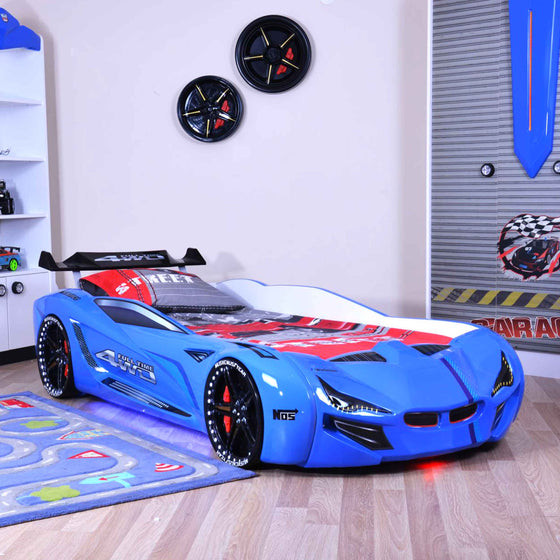As parents, we want our children to feel safe, secure, and comfortable while they sleep. However, sometimes toddlers can resist sleeping in their own beds and prefer to sleep with their parents. While co-sleeping can be a temporary solution, it's essential to help your child transition to sleeping in their own bed for their overall development and independence.
The transition to sleeping in their own bed can be even more challenging for toddlers who have a race car bed. Race car beds are often a favorite among children, with their fun design and exciting features, but it can be challenging to get them to switch to a regular bed. However, with some simple tips and techniques, you can help your child learn to sleep in their own bed, even if it's a race car bed.
Create a Sleep-Friendly Environment
Creating a sleep-friendly environment is the first step towards helping your toddler feel comfortable and secure in their own bed. Toddlers often find it challenging to fall asleep in a noisy, bright, or hot environment, which can result in them seeking the comfort of their parent's bed. By creating a calm and relaxing environment, you can encourage your child to sleep in their own bed and help them establish healthy sleep habits.
Dimming the lights in your toddler's room can help create a relaxing atmosphere that signals to your child that it's time to wind down. You can use a nightlight to provide a soft glow that can help alleviate any fears of the dark that your child may have. Additionally, make sure the room is cool and well-ventilated to ensure your child stays comfortable throughout the night.
For those who sleep in a race car bed, it's essential to make sure that the mattress is comfortable and supportive. Many race car beds come with a thin, plastic mattress that can be uncomfortable for your child. Consider purchasing a comfortable mattress that is specifically designed for your child's race car bed to ensure they get a good night's sleep.
It's also essential to place the race car bed in a quiet corner of the room away from any distractions, such as toys or electronics. This can help minimize any stimulation that could keep your child from falling asleep. You can also use a white noise machine to help drown out any external noise that may disrupt your child's sleep.
In conclusion, creating a sleep-friendly environment is crucial for helping your toddler sleep in their own bed, whether it's a race car bed or a regular bed. By dimming the lights, keeping the room cool and quiet, and using a white noise machine if needed, you can create a calm and relaxing environment that encourages healthy sleep habits. For those who sleep in a race car bed, make sure the mattress is comfortable and supportive, and place the bed in a quiet corner of the room away from distractions.
Establish a Consistent Bedtime Routine
Establishing a consistent bedtime routine is crucial for helping your toddler learn to sleep in their own bed. A bedtime routine can help your child feel secure and calm before bed and signal to their body that it's time to wind down and prepare for sleep. For those who sleep in a race car bed, incorporating race car-themed books or toys into the bedtime routine can help your child associate their bed with comfort and relaxation.
A consistent bedtime routine should be established and followed every night. This routine can include activities that help your child relax and prepare for sleep, such as taking a warm bath, putting on pajamas, brushing teeth, and reading a bedtime story. You can also incorporate a lullaby or gentle music to help your child drift off to sleep.
It's important to keep the bedtime routine consistent and predictable to help your child feel secure and calm before bed. By establishing a consistent bedtime routine, you can help your child develop healthy sleep habits and make the transition to sleeping in their own bed easier and more enjoyable.
Use Positive Reinforcement
Positive reinforcement can be a powerful tool to encourage toddlers to sleep in their own bed. By using a reward system, such as stickers or small treats, you can reinforce the positive behavior of staying in their bed all night and make the experience more enjoyable for your child.
When using positive reinforcement, it's essential to keep the rewards small and consistent. You can use a sticker chart or a reward box to keep track of successful nights in their bed. Each night that your child stays in their bed, they can receive a sticker or a small treat, such as a piece of candy or a small toy. Over time, you can increase the number of stickers or treats needed to earn a reward, making it more challenging and rewarding for your child.
Address Common Sleep Problems
Many toddlers struggle with common sleep problems, such as nightmares, night terrors, and bedwetting. These issues can make it difficult for your child to feel comfortable and secure in their own bed. Addressing these issues can help your child feel more confident and relaxed, making it easier for them to fall asleep and stay in their bed throughout the night.
If your child is experiencing common sleep problems, there are several strategies you can try to address these issues. For nightmares or night terrors, consider talking to your child about their fears and reassuring them that they are safe. You can also incorporate a calming activity, such as deep breathing or meditation, to help your child relax before bed.
For bedwetting, it's important to be patient and understanding. Encourage your child to use the bathroom before bed and consider using a waterproof mattress cover to make accidents easier to clean up. You can also offer positive reinforcement for successful nights without accidents to help encourage your child.
Addressing common sleep problems is essential for helping your toddler sleep in their own bed, whether it's a race car bed or a regular bed. By ensuring that the bed is safe and comfortable and addressing common sleep issues, you can help your child feel more secure and confident in their own bed. This can make the transition to sleeping in their own bed easier and more enjoyable for both you and your child.
Be Patient and Consistent
When it comes to helping toddlers sleep in their own bed, patience and consistency are key. This process can take time, and there may be setbacks along the way. However, by remaining patient and consistent, you can help your child develop good sleep habits and learn to feel comfortable and secure in their own bed.
It's important to establish clear rules and expectations around sleeping in their own bed and stick to them consistently. This can include establishing a consistent bedtime routine, using positive reinforcement, and addressing any common sleep problems that arise. It's also important to be patient and understanding, even when your child struggles to adjust to sleeping in their own bed.
In conclusion, helping toddlers learn to sleep in their own bed can be a challenge, but with the right approach, it can be a positive and rewarding experience for both you and your child. By creating a sleep-friendly environment, establishing a consistent bedtime routine, using positive reinforcement, addressing common sleep problems, and being patient and consistent, you can help your child sleep in their own bed, even if it's a race car bed.
Remember that this process can take time, and setbacks may occur, but with your support and encouragement, your child will eventually develop healthy sleep habits and learn to feel comfortable and secure in their own bed. With these tips in mind, you can help your child get the restful, rejuvenating sleep they need to grow and thrive.




